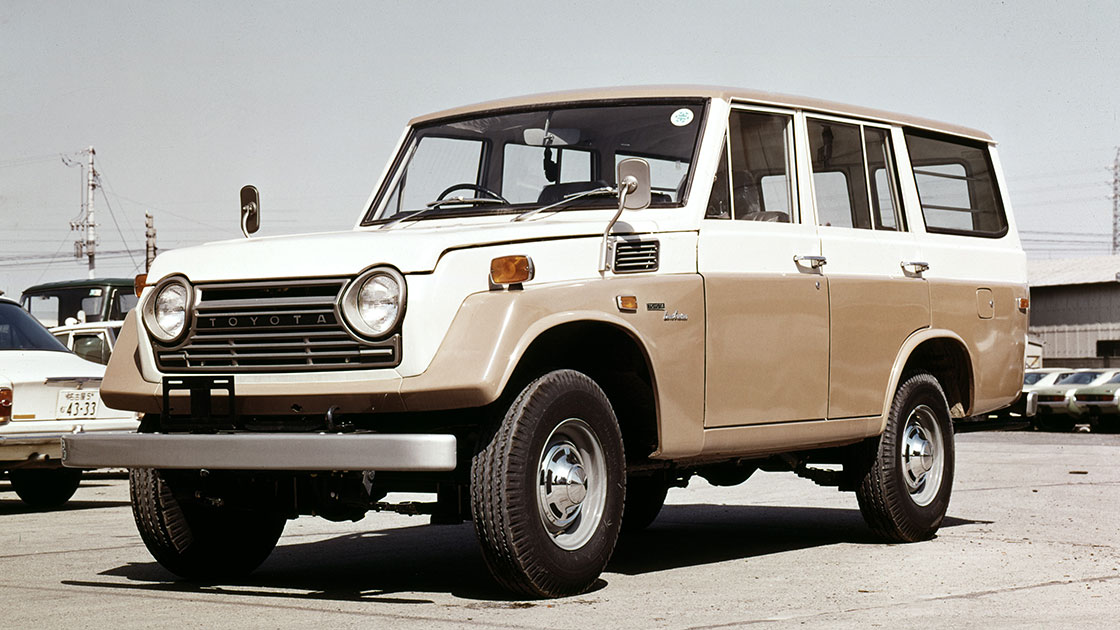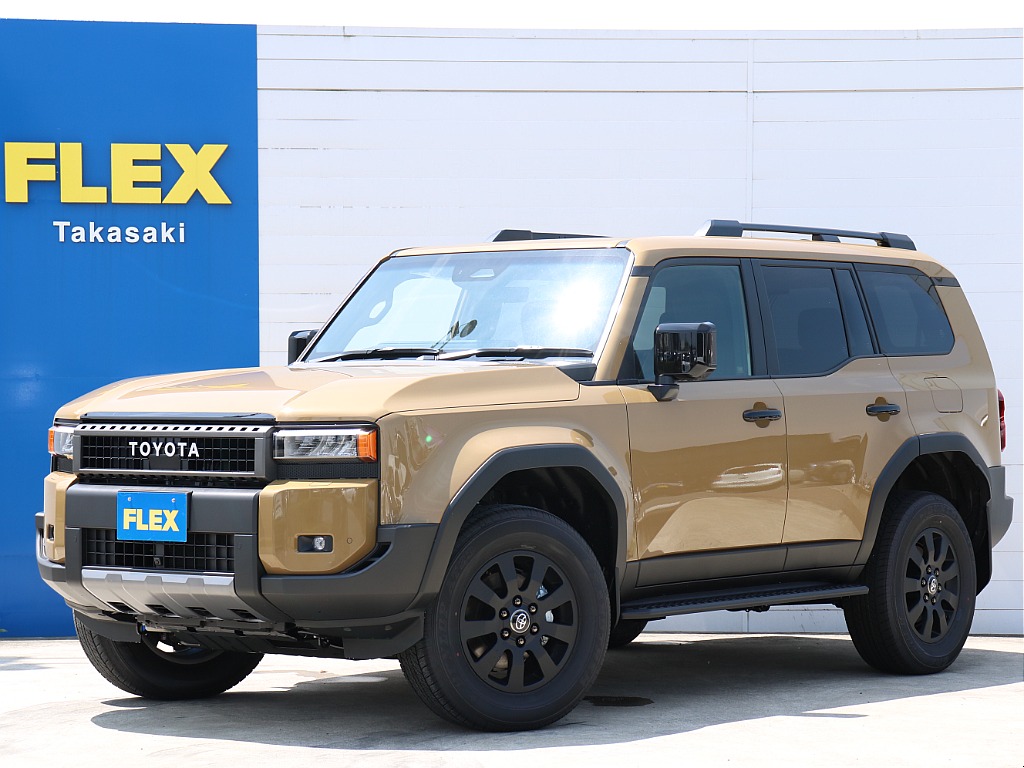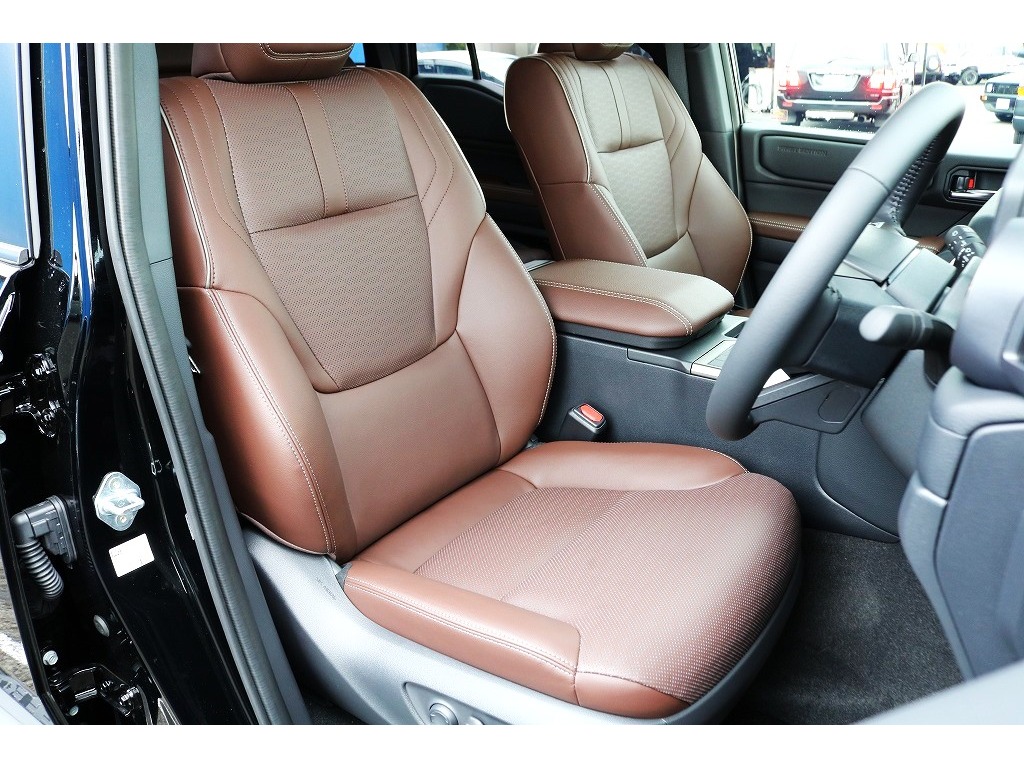Is the 2024 Land Cruiser a real Land Cruiser or an imposter? There seems to be some question amongst enthusiasts as to whether the Prado 250 is the same beast as the 300 or not. In some respects, they could be correct in asking the question, if you consider a “real” Land Cruiser to be a heavy-duty vehicle from the lineup that began with the BJ in 1951 and the J20 in 1955. However, if you’re thinking that a Land Cruiser is just what its name says – a Land Cruiser – , then the new Prado 250 Land Cruiser belongs right beside all of the other beasts in the Toyota compound.
Three Land Cruiser Lines
While the Land Cruiser started as a single model, from there, Toyota pulled the lineup apart and split it into three threads; all based on research, marketability, and visions needed to grow the line and move Toyota toward the successful motor company we see today. One consistent thread is the dependability and ruggedness of all of their body styles.
Station Wagon (50, 60, 80, 100, 200, 300)
Beginning in 1967, Toyota produced the 50, 60, 80, 100, 200, and 300 Series station wagon body style Land Cruisers. The FJ55G and the FJ55V are considered the first station wagon models and had the first model to have a retractable window in the tailgate on the U.S. models. After this first generation, the Land Cruiser had several other evolutions throughout its production. Up to today’s 300 Series, here are some of the key points of those generations:
55 Series (1967-1980)
Introduced as the first “real” station wagon in the Land Cruiser lineup, the FJ55 featured fully enclosed box frame members and a unique tailgate with a retractable window. It was mainly targeted at North American and Australian markets.

60 Series (1980-1990)
A front-engine, four-door wagon that offered improved interior features like air conditioning and a rear heater while retaining rugged off-road capabilities. Production continued in Venezuela until 1992, with various engine options, including petrol and diesel.

80 Series (1990-1997)
Known for its rounded design, earning the nickname “Burbuja,” it introduced full-time four-wheel drive in North America and Europe. The 80 series offered several engine choices and saw the introduction of airbags and ABS.

100 Series (1998-2007)
100 series introduced independent front suspension (IFS) for better on-road handling, though it was criticized for reducing off-road capability. It also featured the debut of a V8 engine and various technological advancements like Active Height Control and the world’s first series-production active night vision system.

200 Series (2007-2021)
Built on a new, stronger platform shared with the Lexus LX 570, the 200 series introduced modern safety and driver-assist technologies. Despite facing criticism for conservative styling, it was available with various powerful engine options. The series received a facelift in 2015 and was discontinued in North America after 2021.

300 Series (2021-Present)
Unveiled in June 2021, the J300 series is built on the new GA-F platform, with a redesigned, lighter, and more rigid frame. It introduced advanced features like an adaptive suspension system and replaced V8 engines with twin-turbo V6 options. The J300 is not sold in the U.S. or Canada; however the J250 Series is available as of 2024 in those markets.

Heavy Duty (BJ, 20, 40, 70)
In the 1950s, Toyota developed the “Jeep” BJ prototype during the Korean War, featuring a 3.4L engine and part-time 4WD for the U.S. military. After the BJ successfully climbed Mount Fuji in 1951, it secured an order from Japan’s National Police Agency. Production began in 1953, and in 1954, it was renamed “Land Cruiser” to compete with the British Land Rover, and a more powerful 3.9L engine was soon introduced. The first Land Cruisers were heavy-duty machines to meet the military’s expectations.
J20 Series (1955-1960)
The second-generation Land Cruiser, known as the 20 Series, featured more stylish bodywork and improved ride quality. It became the first Japanese vehicle exported to Australia and was produced in Brazil starting in 1958, where it was known as the “Bandeirante.”

Photo by en.toyota-club.eu
J40 Series (1960-1984)
The iconic 40 Series introduced low-range gearing and a more powerful engine. By 1965, it was Toyota’s best-selling vehicle in the U.S., and production surpassed 100,000 units by 1968. The 1970s saw the introduction of diesel engines, front disc brakes, and power steering.

J70 Series (1984-Present)
The 70 Series, introduced in 1984, featured various configurations and evolved into the Land Cruiser Prado. It became the first Japanese 4WD vehicle to offer an automatic transmission. The series received significant updates over the years, including new diesel engines and suspension improvements, and remains popular in regions like Africa and Australia.

Light Duty (70, 90, 120, 150, 250)
In November 1984, Toyota introduced the light-duty 70 Series, also known as the Land Cruiser II or Bundera, depending on the region. Available only in short-body, two-door configurations with a 2,310 mm wheelbase, it featured soft or hard plastic tops. Engine options included 2.4L petrol (22R, 22R-E) and diesel (2L, 2L-T) engines, with both naturally aspirated and turbocharged versions available.
J70 Series (1990-1996)
In April 1990, Toyota launched the Prado within the J70 series, featuring a redesigned front, upgraded suspension, and new engine options, including a 2.4L turbocharged diesel. Available in 2-door and 4-door versions, the Prado was geared toward on-road use, offering enhanced comfort and improved handling while retaining a body-on-frame design.

J90 Series (1996-2002)
The J90 series Prado, introduced in May 1996, became an independent light-duty model with a longer body and independent front suspension. Available in 3-door and 5-door versions, it offered engines like the 2.7L 3RZ-FE, 3.4L V6 5VZ-FE, and 3.0L 1KZ-TE diesel. Globally, it was marketed under various names, including the Land Cruiser Colorado in the UK.

J120 Series (2002-2009)
The third-generation Prado, launched in 2002, featured upgraded front suspension and improved reliability. It initially offered engines like the 2.7L 3RZ-FE, 3.4L V6 5VZ-FE, and 3.0L turbo diesel 1KZ-TE, later upgraded to the 2.7L 2TR-FE and 4.0L V6 1GR-FE. Sharing suspension components with the Hilux Surf/4Runner and FJ Cruiser, the J120 series also introduced advanced features like Japan’s G-BOOK telematics service.

J150 Series (2009-2023)
The fourth-generation Prado, introduced in October 2009, came in 5-door and 3-door variants, emphasizing advanced 4WD systems and off-road navigation tech like multiple camera views. Engine options included a 4.0L V6 1GR-FE and a 2.8L turbo-diesel, with power and emissions updates in 2015 and 2017. The Prado remained popular, especially in Australia, with trims like GX, GXL, VX, and Kakadu.

J250 Series (2023-Present)
The J250 series Prado, unveiled in August 2023, combines a retro-inspired boxy design with modern practicality and durability. Built on the GA-F platform, it features increased frame rigidity and electric power steering for better off-road handling. Known as the Land Cruiser 250 in Japan and North America, it retains the Prado name elsewhere. Engine options include a hybrid 2.4L turbo, and the model offers advanced off-road capabilities with full-time four-wheel drive and electronic locking differentials.

Classification of car models in the U.S.
In the United States, cars are classified into several categories based on their size, design, and purpose. Here are the main classifications:
- Sedans – subcompact, compact, mid-size, and full-size
- Coupes – 2-door cars with sporty designs like the Mustang built on a sedan platform
- Hatchbacks – cars with a swing-up rear door
- Station Wagons – extended hatchbacks that may include third-row seating
- Convertibles – anything with a retractable roof
- SUV – subcompact, compact, mid-size, and full-size
- Crossover – a blend of a car and an SUV usually built on a car platform
- Minivan – family-size passenger vehicles
- Pickup Trucks – compact, mid-size, full-size, and heavy-duty
- Vans – passenger vans like Sprinters and cargo vans like the Transit
- EVs – any fully electric-powered vehicle
- Hybrid – any vehicle that combines an engine with an electric motor
These classifications are often used by manufacturers, regulatory agencies, and consumers to categorize vehicles.
Full-Size Luxury SUVs (LX450, LX470, LX570, LX600)
Debuting in the mid-1990s, the LX450, LX470, LX570, and LX600 are Lexus’s pinnacle full-size luxury SUVs, blending rugged off-road capability with refined comfort and advanced technology.
J80 Series (1995-1997)
Launched in 1996, the LX 450 featured a 4.5L inline-six engine, seating for seven, and shared its design with the Toyota Land Cruiser J80. It offered a more luxurious interior, softer suspension, leather seats, an optional CD changer, electronic locking differentials, and a power moonroof.

J100 Series (1998-2007)
The LX 470, launched in 1998 with a 4.7L V8 engine, shared many components with the Land Cruiser Cygnus. It offered a luxurious interior, quad-headlamps, and advanced suspension systems like Adjustable Height Control (AHC). Updates in 2003 and 2005 added features like a Mark Levinson sound system, Bluetooth, and a backup camera.

J200 (2007-2021)
The LX 570, introduced in 2007 with a 5.7L V8 engine, offered increased power, towing capacity, and advanced off-road features like Crawl Control. Luxury upgrades included a 19-speaker Mark Levinson sound system and a hard-drive navigation system. Facelifts in 2012 and 2015 added design and tech enhancements.

J250 (2021-Present)
The latest LX, introduced in October 2021, features a twin-turbo V6 engine and seating for four or seven passengers. It blends luxury with advanced off-road capabilities and is marketed as the Land Cruiser 250 in Japan and North America.

Light Duty (GX470, GX550)
The Lexus GX is a mid to full-size luxury SUV produced for the North American and Eurasian markets and makes use of the 4×4 Prado as its base.
GX470
The Lexus GX470 was introduced at the North American International Auto Show in 2002 and was equipped with a full-time 4WD and a 4.7L V8 that it shared with the LX470. The 2UZ-FE V8 offered 235 horsepower and 320 lb-ft of torque. It could tow 5,000 pounds in 2003, but by 2004, the GX could tow 6,500 pounds thanks to a stronger tubular hitch. The GX470 was derived from the J120 Prado and had an Adaptive Variable Suspension and Downhill Assist Control.
The interior featured two rows of seating and an optional third row that increased the passenger capacity to 8. It was in production from 2002-2009 and received accolades from J.D. Power and Associates as the highest-ranked premium luxury SUV in initial quality for the 2005 models. Four Wheeler Magazine gave it the Four Wheeler of the Year award in 2003 and 2004.

Photo by Lexus
GX550
The 2024 Lexus GX550, unveiled at the 2023 Pebble Beach Concours d’Elegance, sports a new 3.4L twin-turbo V6 engine delivering 349 horsepower and 479 lb-ft of torque with a towing capacity of 8,00 pounds and entered the market in 2023. It is a bit more squared off in appearance than its predecessors and shares a family link to the J250 Land Cruiser Prado. It is the first GX model to be offered in Japan and Australia. The GX550 is larger than the outgoing GX model and available in six grades: Premium, Premium+, Luxury, Luxury+, Overtrail, and Overtrail+. The Overtrail trim focuses on off-roading, with features like E-KDSS and multi-terrain select. A hybrid option is on the horizon.

Photo by Lexus
How the genealogy diverged
Based on market studies and intuition, Toyota looked forward to marketplaces beyond their shores and made solid decisions about what it wanted the future to hold for it. As Toyota examined the terrains and needs of people other than those at home, it began to envision users from around the world getting behind the wheel of a Land Cruiser. This forethought gave us vehicles like the Lexus LX, as well as the Prado and the Land Cruiser 300.
1967: The Land Cruiser 50 series, the pioneer of luxury-oriented SUVs
From 1967 to 1980, Toyota churned out the Land Cruiser 55, also known as the FJ55G and FJ55V. These models were the first in the lineup to rock the “real” station wagon vibe, setting the stage for all future wagon styles in the series. They stood out as the first to sport fully enclosed box frame members. Unique among U.S. Land Cruiser wagons, including the older FJ45, the FJ55 was the only one featuring just a tailgate at the back, complete with an electric window that rolled right down into it, skipping the usual hatch and tailgate combo.
The FJ55V debuts as the successor to the long-bodied FJ45V
The FJ55V was based on the drivetrain of the FJ40, but it sported a longer wheelbase of 106 inches and was painted in a distinct 2-tone paint scheme. It was produced for the American and Australian markets and was also offered as a fire engine with no doors and open bodywork. Dubbed the “Moose” or the “Iron Pig” due to its piggy face, this blocky monster saw almost 113,000 units go out the door over its lifetime.
There is a resurgence of popularity of the FJ55V as younger off-road enthusiasts are discovering these rough-and-tumble vehicles.
Four-wheel drive vehicle that is both quiet and comfortable to drive.
Between the versatility, the suspension upgrade, and the interior comforts, the FJ55V delivers a quiet interior that belies its ability to take on the harshest of landscapes. Don’t let the quiet fool you; it’s a powerhouse under the hood.
1984: The “Land Cruiser 70 Wagon,” the predecessor of the Prado, was born.
Back in 1984, Toyota rolled out the Land Cruiser 70 Wagon, a perfect fusion of the rugged allure of classic Land Cruisers and modern comforts, that would soon become synonymous with the Prado series.
This ride was all about giving passengers a comfortable experience without sacrificing the tough, go-anywhere prowess the Land Cruiser family is known for. Perfect for both off-road adventures and family outings, the 70 Wagon set the stage for the Prado’s evolution into a sleek SUV with wilderness experience and street cred. This shift was a big deal for Toyota, paving the way for the Prado to become one of the brand’s most beloved and dependable SUVs.

Model with improved on-road ride comfort
As the J70 evolved into the Prado 70, so did its suspension, which led to a smooth and comfortable ride both on and off-road. Toyota put a four-wheel coil spring solid-axle suspension in the 70 Light (before it became the Prado 70) that delivered performance in the city and on the trails.
Land Cruiser 70 Prado, the first model to bear the “Prado” name
Introduced in 1990, the Land Cruiser 70 Prado – the first model to carry the Prado name –distinguished itself from its predecessors by retaining the Land Cruiser’s signature tough body-on-frame construction while incorporating a passenger-friendly interior.
Despite its focus on comfort, the 70 Prado did not compromise on its off-road capabilities. It was powered by one of four engine options: 2.4L 22R (carb) or 22R-E (EFI) gas engines, or 2.4L 2L or 2L-T diesel and turbo diesel motors.
Prado is the best-selling Land Cruiser series in Japan
The Toyota Land Cruiser Prado enjoys strong popularity in Japan, where it was equipped with a 2.4L turbo diesel capable of 95 horsepower and 177 lb-ft of torque. It was available in a 2-door or 4-door body and three trim levels total, with the EX only offered in a 4-door.

Prado’s New Car Sales in the Land Cruiser Series
Toyota Japan expects to sell 2,250 new 250 Series a month with the number for annual sales projected to be 27,000. These sales figures include the 8,000 special edition models.
Seven reasons why the Land Cruiser Prado is sought after
The Land Cruiser Prado has garnered strong support and loyalty over the years due to several key factors that make it a standout in the SUV market. Here are six reasons why the Land Cruiser Prado is highly regarded:
1. Legendary Reliability and Durability
For no other reason than it’s a Toyota, the Prado 70 is a member of the reliability club. Known for its bullet-proof engines, Toyota enjoys a remarkable history of high mileage vehicles, and the Prado 70 is no different.
The solid 4WD system and advanced traction control make tough terrains no problem. The engine lineup gives you plenty of power options to choose from, and with the Toyota history behind it, the Prado will deliver performance and power for years and miles to come.

2. Exceptional Off-Road Capabilities
It’s smaller, so whipping around city corners, changing lanes on the highway, or spinning around a tree on the trail can all be done with ease.
With features like advanced four-wheel-drive systems, high ground clearance, and rugged suspension, it is capable of handling rough terrains, steep inclines, and deep water crossings.
3. Safety performance and equipment
The Toyota Land Cruiser Prado is equipped with advanced safety features like Pre-Collision Safety (PCS), Lane Departure Alert (LDA), and Adaptive Cruise Control (ACC). Additionally, the Prado offers multiple airbags, a reinforced body structure, and stability control systems, ensuring a high level of safety performance both on and off the road.
4. Comfort and Luxury
While it is a rugged off-roader, the Prado does not compromise on comfort. The interior is designed with high-quality materials, comfortable seating, and advanced technology features.
You’ll find plenty of room in the Prado. Seats fold down for more cargo space, or you can split the seats and have room for both cargo and kids. There are many pockets and storage compartments inside the cabin, so there are nooks and crannies of all sizes.

5. Strong Resale Value
The Toyota Prado holds a strong resale value, if for no reason other than its off-road toughness. It is not unusual for the Land Cruisers to have hundreds of thousands of miles on them and still deliver peak performance. However, there is always a market of Land Cruiser fans looking for a used Prado.
The Toyota Land Cruiser Prado’s price varies depending on the model and features, but it generally starts at around ¥4.5 million (approximately $30,000) in Japan. Higher-end models with additional luxury features and advanced off-road capabilities can reach up to ¥6.5 million (around $45,000). Prices can vary based on region, specifications, and optional features
6. Global Reputation
The Prado is part of the larger Land Cruiser family, which has a global reputation for being one of the most capable and dependable SUVs available.
7. Versatility
The Prado is incredibly versatile and capable of serving as a family vehicle, a workhorse, or an adventure companion. It offers a range of configurations and options, including multiple seating arrangements, engine choices, and trim levels, allowing customers to tailor the vehicle to their specific needs.
FLEX is the best place to get a Prado.
If you’re ready to buy a Prado, then Flex is the place to turn to for everything Land Cruiser. We’re the number one Land Cruiser dealership in Japan and have a San Diego office for our North American friends. Our experienced sales staff can answer your Land Cruiser questions.
The most exciting part about Flex is our Renoca series where we take what is new and make it old. For those who love the traditional boxy appearance but can’t live without the modern conveniences of the newer models, Flex offers a retro-mod kit that delivers a high-tech heart beating in a square body. Questions? Contact us and let’s talk about the Land Cruiser of your dreams.




